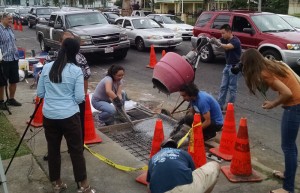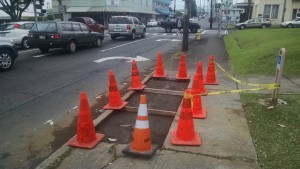‘Lunar Concrete’ May Pave the Way for Sustainability
On Thursday afternoon, the Hawai’i County Department of Research and Development laid the groundwork for three slabs of concrete that will act as prototypes for a sidewalk made of what is being called “lunar concrete.” The project is being done along Kinoole Street, on the opposite side of Lincoln Park, and along the tennis courts in Downtown Hilo.
The project, which is testing out volcanic basalt fines rather than using tradition cement, is a collaboration between the Department of Research and Development, Pacific International Space Center for Exploration Systems, NASA, University of Hawai’i at Manoa, and Kodiak FRP Rebar.
Slabs of the basalt fines, which are a byproduct found in local quarries, are being held together with an assortment of binding agents, including fly ash basalt paver, aerated foam basalt paver, and baked basalt paver. One of the slabs will also use rebar made from basalt rather than traditional steel, to reinforce the pavement.
PISCES officials say basalt rebar is 25 percent lighter than steel, but is also twice as strong. Another benefit of the basalt rebar is its extreme resistance to corrosion.
The year-long project is being funded by the Department of Research and Development and will be monitored throughout the year to see which of the methods of binding proves to be the most effective. The “lunar walk” will be monitored and analyzed to see how the slabs will hold up in comparison to traditional concrete.
This project proves much more than a simple science experiment. Officials hope that the concrete, if effective, could provide an option for a sustainable alternative to traditional concrete in Hawai’i.
According to PISCES, Hawai’i reportedly uses 300,000 metric tons of cement shipped in from Portland each year. Beyond the state’s use of cement, production accounts for 5 to 7 percent of CO2 emissions globally.
With the development of “lunar concrete,” PISCES hopes to assist in the State of Hawai’i’s economic and environmental cost reduction associated with the use of cement.
Aside from local benefits, the project could also provide further implications for a groundbreaking method of building structures and human bases on other planets. PISCES officials say the volcanic basalt is nearly identical to the dirt found on the Moon, as well as other planets like Mars and even on asteroids. If found to be effective, the development of “lunar concrete” could provide a new world of opportunity.

















